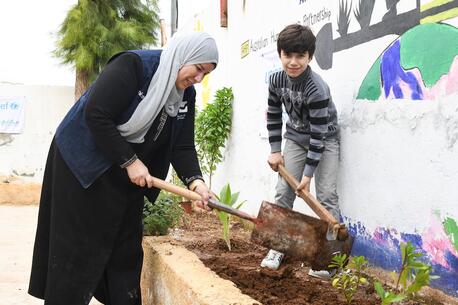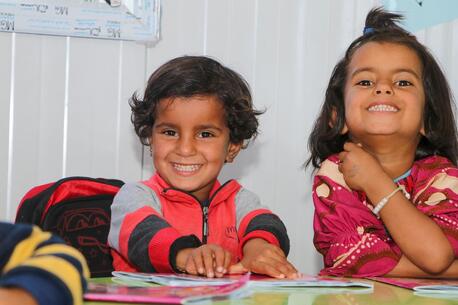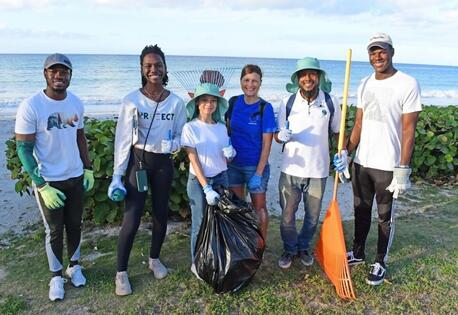The Benefits of Building Classrooms out of Recycled Plastic Bricks
A firsthand look at an innovative program to improve learning, encourage environmental action and empower women in Côte d’Ivoire.
Learning, laughing — and adapting
The Plastic Bricks Project in Côte d’Ivoire is an innovative program that mobilizes women to collect plastic waste that is then converted into bricks to build local school classrooms.
The project was inspired by a bold idea and implemented by brave pioneers willing to take a chance and to adapt along the way. It is part of UNICEF Côte d’Ivoire’s country program to improve learning, encourage environmental action and empower women.
Since the 2019 launch, 383 classrooms have been built using over 3,000 tons of plastic, providing 19,150 children with new school infrastructure. Thousands more children and teachers have been reached with additional education support.
UNICEF USA has been supporting and following the project’s progress for years. I recently traveled to Côte d’Ivoire as part of a partner delegation to learn more.
Here are 10 things UNICEF learned while implementing this complex program:
1. Green collection points prevent unsafe storage of plastic refuse.
Collecting trash from a landfill is not the safest work; women were cleaning and storing plastic waste in their homes, creating health risks to themselves and their families. UNICEF and partners are establishing green collection points in strategic locations to make it easier and safer to clean and store the plastic.
2. Private sector contributions are essential.
The project needed at least 1,000 women to collect plastic trash to keep pace with the need. However, fewer than 200 women were recruited. As a solution, about 70 percent of the plastic waste is purchased from the private sector — creating an incentive for local entrepreneurs and supporting the market for recycled plastic waste.
3. Avoid competing for plastic bottles.
Beverage companies already buy plastic bottles, so to avoid undermining or directly competing with that market, the UNICEF program focuses on non-PBA plastic waste. This practice allows women to work not only with UNICEF partner Conceptos Plásticos, a Colombian social enterprise that manufactures the recycled plastic bricks, but to also sell to other entities.
4. Collectives prevent profiteering.
Women were selling their plastic waste to middlemen — who were buying at the very low price of 27 francs per kilo and then selling it on the private market for 500 francs per kilo. So UNICEF helped form a women’s collective to negotiate better prices.
Now the women collecting plastic for the program are able to sell it for 200 francs per kilo — with half going to the women, and half going to the collective.
5. A trained workforce is needed to streamline the process of building classrooms with the plastic bricks.
UNICEF hosted trainings for engineers, construction workers and designers with an emphasis on training and employing women.

6. Plastic bricks are not suitable for everything.
Builders discovered that the plastic bricks were not suitable for bathrooms because their surface is too porous and too difficult to keep clean. The potential solution: cover existing plastic-brick bathrooms with plaster and use alternative materials to construct future facilities.
7. Building classrooms is labor-intensive and doesn’t play to UNICEF’s strengths.
Rather than overseeing the construction projects, UNICEF is pivoting to “buying” classroom building kits for others who have been trained to work with the new material to assemble.
8. Plastic bricks can be used to build other things schools need.
UNICEF has a prototype desk made from plastic bricks, a longer-term solution to the wooden desks students currently use. Plans are underway to put the prototype into production.
9. Equipping plastic-brick schools with water, sanitation and hygiene (WASH) facilities is important for student health and well-being — and school attendance — but it’s not enough.
Without proper WASH facilities and support at home, kids can still get sick. UNICEF’s education team has partnered with the UNICEF WASH team in Cote d’Ivoire to explore expanding community WASH programs in neighborhoods to reinforce healthy practices.
10. Children laughing and learning in colorful classrooms is inspirational!
In addition to the construction of classrooms, UNICEF is also working with its partners in Côte d’Ivoire to ensure quality instruction and improve learning outcomes. In 2023, UNICEF USA donor support helped UNICEF purchase teaching and learning materials for 37 plastic brick schools, benefiting 12,210 children.
Classroom furnishings were also provided to 111 primary school classrooms and 21 preschools, benefiting 6,600 children. And 492 teachers received training.
When trying new approaches, flexible funding is essential to meet unanticipated challenges and allow the staff to pivot when needed.
Becoming a monthly donor is the best way to support UNICEF's mission to create a more equitable world where every child is healthy, educated, protected and respected.
Learn about other ways to give.
Darla Silva is Chief Program Officer at UNICEF USA.


